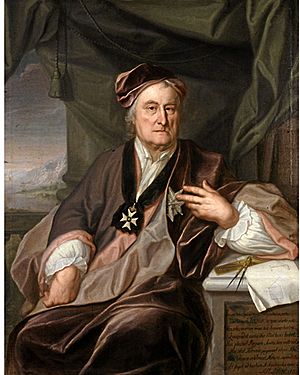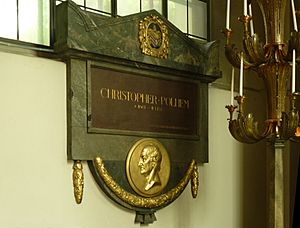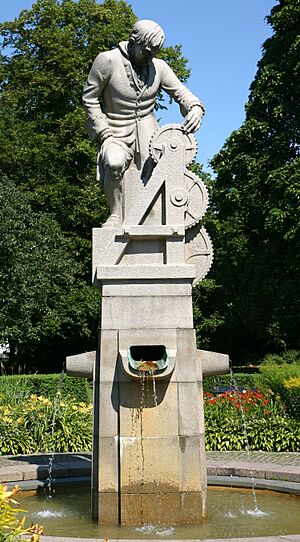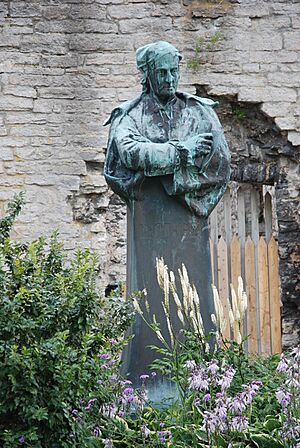Christopher Polhem facts for kids
Quick facts for kids
Christopher Polhem
|
|
|---|---|

Portrait of Christopher Polhem by Johan Henrik Scheffel, 1741.
|
|
| Born | 18 December 1661 |
| Died | 30 August 1751 (aged 89) |
| Nationality | Swedish |
| Alma mater | Uppsala University University of Harderwijk |
| Known for | Göta Canal Various inventions |
| Awards | Order of the Polar Star, Head of the Royal Swedish Academy of Sciences. Enobled in 1716 |
| Scientific career | |
| Fields | Physics, Mechanics |
Christopher Polhem was a brilliant Swedish scientist, inventor, and businessman. He was born Christopher Polhammar on December 18, 1661. He later changed his name to Polhem after being made a nobleman in 1716.
Polhem helped Sweden grow its economy and industries, especially in mining. King Charles XII of Sweden even made him a nobleman because of his amazing work. He is remembered for his many inventions and for helping build the Göta Canal.
Contents
About Christopher Polhem
Christopher Polhem was born on the island of Gotland in Sweden. His father, Wolf Christoph Polhammer, came from Hungary. He moved to Sweden because of religious reasons. He was a trader and later became a ship captain.
Polhem's father died when Christopher was only eight years old. His mother remarried, but Christopher had problems with his stepfather. This meant he could no longer afford private lessons. So, he went to live with his uncle in Stockholm.
Early Life and Learning
Polhem started working as a farmhand. He was very good with numbers and quickly became a supervisor. He was in charge of managing the farm and keeping records. He worked there for ten years.
During this time, he also built a small workshop. He made tools and fixed machines to earn extra money. Polhem loved learning about math and machines. He soon realized he needed to learn Latin to study more.
He tried to learn Latin by himself, but it was too hard. He found a local priest who agreed to teach him Latin. In return, Polhem built a complex clock for the priest.
News of Polhem's amazing mechanical skills spread. A priest wrote to Anders Spole, a math professor at Uppsala University. Spole was the grandfather of the famous scientist Anders Celsius.
Professor Spole gave Polhem two broken clocks. He said Polhem could study at the university if he could fix them. Polhem fixed the clocks easily. In 1687, at age 26, he started studying at Uppsala University.
Family Life
Polhem married Maria Hoffman in 1691. They had eight children together.
In 1716, King Charles XII made him a nobleman. This was to thank him for his great work for Sweden. He then changed his last name from Polhammar to Polhem.
In 1739, Polhem and his son Gabriel were both chosen to be members of the Royal Swedish Academy of Sciences. This academy was founded in the same year.
Christopher Polhem passed away peacefully in Stockholm in 1751. He was 90 years old.

Polhem's Amazing Career
Fixing the Uppsala Clock
Polhems career really took off after he fixed a very old clock. This clock was an astronomical clock from the 16th century. It was in Uppsala Cathedral and had been broken for over 100 years! Polhem successfully repaired it.
Improving Mining
In 1690, Polhem was asked to make mining in Sweden better. Mining was dangerous and slow back then. He designed a new system to lift and move ore from the mines.
His system used a track and was powered by a water wheel. This meant fewer people were needed for the dangerous work. Only a few workers were needed to load the containers.
This new system was revolutionary. King Charles XI of Sweden heard about it and was very impressed. He asked Polhem to improve Sweden's biggest mine, the Falun Mine.
The Mechanical Laboratory
The Swedish mining authority gave Polhem money to travel around Europe. He studied new mechanical ideas and inventions. He came back to Sweden in 1697.
He then started a place called laboratorium mechanicum in Stockholm. This was a special place to train engineers. It was also a lab where he could test his new designs. Today, this place has grown into the famous KTH Royal Institute of Technology.
The Stjärnsund Factory
One of Polhem's biggest achievements was an automated factory. It was built in 1699 in Stjärnsund. This factory was powered entirely by water. This was very unusual for that time!
The factory made many things, like knives, locks, and clocks. Polhem believed Sweden should process its own raw materials instead of just exporting them.
Workers were worried that machines would take their jobs. Sadly, most of the factory was destroyed in a fire in 1734. Only the part that made clocks survived.
The factory kept making clocks. They were known for being high quality and affordable. Even today, clocks based on Polhem's design are still made in Stjärnsund.
The factory also made "Polhem locks." These were an early design of the padlocks we use today. The factory wasn't very profitable, but King Charles XII supported Polhem. He even gave him tax breaks to help his efforts.
The famous scientist Carl Linnaeus visited the factory. He wrote in his diary that "Nothing is more optimistic than Stjärnsund."
The Göta Canal
Polhem also helped build the Göta Canal. This canal connects the east and west coasts of Sweden. He worked with King Charles XII to plan parts of the canal. He designed the canal locks in the 18th century. The canal was finally finished in 1832, long after Polhem's death.
He also designed dry docks and dams. He worked on these projects with his assistant and friend, Emanuel Swedenborg.
Other Interests
Polhem was not just a mechanic. He also wrote essays on many topics. These included medicine, social criticism, astronomy, geology, and economics. He was truly a man of many talents!
Key Accomplishments
- He started the Stjärnsunds manufakturverk factory in 1700.
- He independently reinvented the Cardan joint. He called it the "Polhem knot."
- He organized machines into a "mechanical alphabet." This was a collection of models showing how different machine parts worked. Out of 80 wooden models, 32 are still at the National Museum of Science and Technology in Stockholm. Another 13 models are at the Falun Mining Museum.
Polhem's Legacy
- His picture was on the back of the 500 Swedish kronor banknote from 2001 to 2016.
- The Polhem Prize (Polhemspriset [sv]) is named after him. It is given to important people in engineering and industry.
- There are statues of Christopher Polhem in Sweden. One is in Visby and another in Gothenburg.
See also




